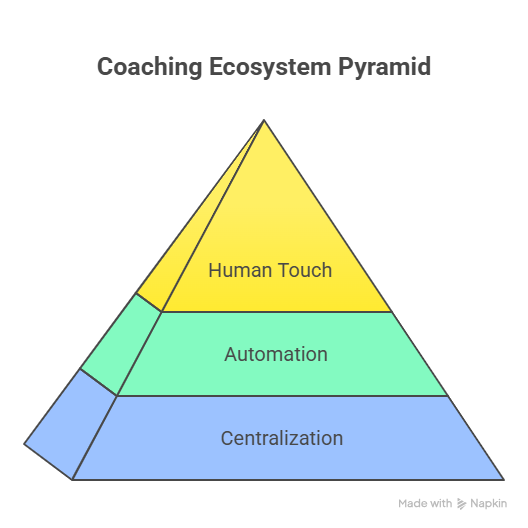15 Must-Have Coaching Tools Every Professional Needs in 2025
Coaching in 2025 demands more than intuition and expertise—it demands infrastructure. The most successful coaches aren’t just skilled; they’re supported by tools that amplify clarity, improve client results, and create seamless operational experiences. But choosing the right stack is overwhelming. That’s why this guide goes far beyond surface-level recommendations. Here, you’ll find the tools every professional coach needs to compete in an industry reshaped by automation, personalization, and digital ecosystems—rooted in insights reflected across ANHCO resources like branding frameworks and scaling strategies.
1. Why Choosing the Right Coaching Tools Defines Your Entire 2025 Growth Trajectory
The coaching industry has evolved into a hybrid discipline: half strategic guidance, half digital experience. Clients are no longer impressed by talent alone—they judge you by the systems that support every interaction. From onboarding to accountability check-ins, your tools determine trust, consistency, and perceived professionalism. This is why coaches highlighted in How Certification Differentiates Your Health Coaching Business and The Hidden Revenue Streams Most Coaches Overlook scale faster: their tools eliminate friction and elevate client experience at every stage.
A powerful tool stack allows you to deliver both precision and warmth. Automation increases reliability; human touch preserves transformation. When your tools work in sync with your coaching methodology, your practice becomes unstoppable—capable of handling higher client capacity, better retention, and seamless expansion into digital products, group programs, and retreats.
This foundation sets the stage for the 15 must-have tools every professional coach needs in 2025.
2. The 15 Must-Have Coaching Tools Every Professional Needs in 2025
2025 is the year where tools separate hobbyists from true professionals. The difference is not in talent—it’s in infrastructure. The right tools eliminate friction, reduce cognitive load, and improve the emotional safety of your coaching container. This is echoed across ANHCO best-practice guides such as Financial Management Hacks and How to Build a Coaching Team.
Below are the tools you must have to stay competitive:
1. Automated Scheduling System
Manual scheduling is dead. A modern scheduler ensures clients can book instantly without ping-pong messaging.
2. Coaching CRM
This is your memory, personalization engine, and system of truth.
3. AI Session Prep Tool
Summaries, insights, and follow-up suggestions.
4. Client Portal
A secure space where clients access resources, notes, and action plans.
5. Payment & Subscription Processor
Professional billing builds trust immediately.
6. Habit & Accountability Tracker
Daily consistency = faster transformation.
7. Email Automation Tool
Warmth delivered at scale.
8. Workflow Automation Tool (Zapier/Make)
Your invisible assistant.
9. Course / Module Platform
Hybrid coaching dominates 2025.
10. Community Platform
Connection creates retention.
11. Analytics Dashboard
Coaching is now data-driven.
12. Voice Note Platform
Quick emotional support between sessions.
13. Secure Contract / E-Signature Tool
Clean onboarding increases conversions.
14. Session Recording + Transcription Tool
Replay builds long-term retention.
15. Content Scheduling Tool
A must-have for visibility and thought leadership.
Each tool amplifies a different part of your coaching DNA. Together, they create a system powerful enough to scale without sacrificing connection.
3. How These Tools Improve Client Results
Coaching tools are often discussed in terms of efficiency, but their largest impact is psychological. Clients experience more safety and clarity when supported by structured systems. Automated reminders reinforce their identity as someone who follows through. Learning portals create consistent engagement between sessions. CRM-driven personalization helps clients feel seen and understood. These insights align with transformation methodologies featured in Hosting Successful Coaching Retreats and Achieving Financial Freedom Through Coaching.
When your sessions start with preparation instead of fumbling through notes, clients feel cared for. When your entire workflow is smooth, they interpret it as professionalism. Tools don’t replace coaching—they elevate it.
Poll: Which Coaching Tool Do You Struggle Selecting Most?
4. Building Your 2025 Coaching Tech Stack the Right Way
The biggest mistake coaches make is collecting random tools without designing a cohesive ecosystem. A powerful stack is built around three principles:
1. Centralization – One source of truth
2. Automation – As much efficiency as possible
3. Human Touch – Injected where it matters most
This balance mirrors strategies from Leveraging LinkedIn and Choosing the Perfect Name for Your Coaching Business—clarity, consistency, and cohesion.
Start small. Automate onboarding. Organize client profiles. Add accountability tools. Then build up toward a full automation ecosystem. Your system should feel intuitive, not complex. Every tool should reduce your cognitive load, not add another.
5. The Future: AI and Automation Tools Reshaping the Coaching Industry
AI tools are no longer optional—they give modern coaches a competitive advantage. AI-enhanced CRMs predict client patterns. Voice-to-text tools reduce prep time drastically. Analytics dashboards reveal progress bottlenecks. You’ll see parallels to emerging trends explained in 2025 Health Coach Certification Trends and Blockchain Technology in Coaching.
The future of coaching blends precision automation with emotional depth. AI handles structure; humans handle transformation. Coaches who resist this trend fall behind. Coaches who embrace it build scalable, sustainable, and deeply human coaching ecosystems.
6. FAQs — 15 Must-Have Coaching Tools Every Professional Needs in 2025
-
Your CRM. It controls personalization, organization, retention, and experience quality. Without it, scaling becomes chaotic.
-
Between 8–15, depending on business size. The key is integration, not quantity.
-
They remove friction, create clarity, reinforce habits, and support consistent engagement between sessions.
-
Yes. Tools support the container. Transformation still comes from human connection.
-
A scheduler, CRM, branded forms, a client portal, and automated onboarding.
-
Not if used correctly. Automation enhances structure; authenticity comes from you.
-
Using too many or choosing them without designing a unified system.
-
Pick tools based on client behavior patterns, program structure, and the emotional intensity of your coaching style.


